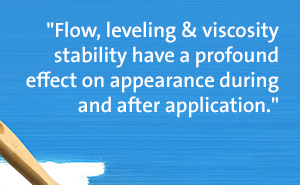Ron Lewarchik is a contributing author to UL Prospector and publishes articles monthly. Please read on for his expert findings on “Flow, Leveling & Viscosity Control in Waterborne Coatings”:
Flow, leveling and viscosity stability can be very challenging and problematic in waterborne ambient cure and baked finishes. These issues can affect not only package stability, but also have a profound effect on appearance during and after application. As the vast majority of waterborne coatings are anionic in nature (amine (EU) neutralized), this article will focus on amine neutralized resin types, although if resin polarity, for example from acid functionality, is high enough, anionic resin types can be dispersible or even water soluble without the use of neutralizing amine.
There are two major categories of waterborne paint technologies: water reducible (EU) and latex (EU). For the purpose of this article, water reducible resins are normally made in solvent and then reduced with water to form a resin dispersion in water. Latex resins are made by emulsion polymerization in water. The paints using emulsion resins most often utilize a small amount of organic cosolvent to improve coalescence of the latex particles, as well as substrate wetting.
Other types of waterborne paints utilize a growing number of resin types that include PUD (polyurethane dispersions (EU)) as well as microemulsions. Accordingly, multiple issues can influence the flow, leveling, and appearance of waterborne coatings. This article will primarily examine the impact of 1) resin type, 2) humidity and temperature variation, 3) wetting and 4) flow control. Appearance of the coating during and after application can be affected greatly by these issues.

